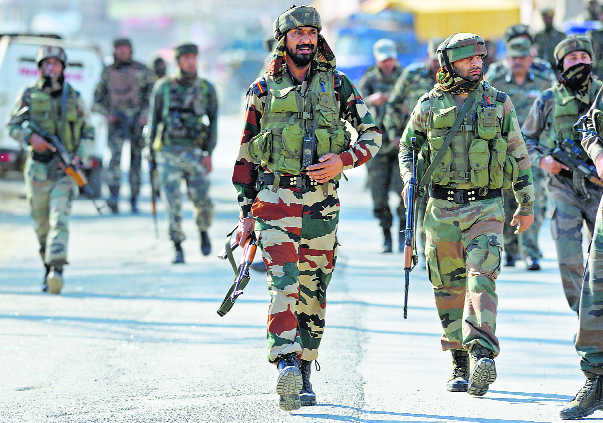
WINDS OF CHANGE: A retiring soldier can no longer fall back on the comfort of a joint family.
Ravi Bhushan
The Tribune had reported on June 13 that the Army Chief has given the go-ahead for cadre review. It has been pointed out that a major chunk of allocated defence budget is spent on salaries and pensions and the money left for modernisation is not adequate to meet even essential upgradation of equipment. The situation is challenging.
The current allocation for defense is 1.57 percentage of GDP but defence experts want the outlay to be at least three percent of GDP keeping in view our heavy dependence on import-oriented modernisation. Given its functional requirements, the Army is a manpower intensive organisation. Downsizing of existing manpower is neither in the best interest of our security needs nor effective functioning of the army.
In order to deliver results, the Army keeps its manpower profile young. Research shows that after the age of 35, the body starts undergoing depreciation particularly in terms of physical strength, stamina and agility. Therefore, one may conclude that the real combat age is up to 42 to 45 years subject to normal conditions.
As such, retaining manpower beyond 45 years of age, regardless of the rank they hold, has deleterious effect on the fighting capability of the force. As a result, the structure of the armed forces, particularly the Army is such that 70-80 per cent manpower is discharged from service in the age profile of 35-42. Every year around 50,000 soldiers from Army, Navy and Air Force exit the services and seek second employment in civil life. The prime of their youth is spent in services, frequently moving from one place of duty to another and by and large remaining disconnected from normal societal life. When they come home, they have prime responsibilities and obligations in terms of financial and social to fulfil since children have grown up by that time.
A radical change came about after 1985 in terms of socio-economic background of soldiers. Earlier, majority of the soldiers used to come from the agrarian background and after completion of their regular engagement they would return home with a modest pension and happily settle down in their family profession or business. The joint family system also helped to a large extent in getting them settled.
However, after 1990s, sociometry of manpower joining armed forces has undergone a sea-change. Though, educational standards increased, most of youth are from weaker social-economic-political background. Therefore, it has become an inescapable necessity for them to seek regular employment after leaving the armed forces. As a result, every ex-serviceman tries his best to get a regular government job. This has brought about joblessness among ex-soldiers owing to the fact that reserved opportunities in government and semi-government sectors are not good enough to absorb such a large number of ex-servicemen.
Further, it would be appropriate to throw light on major three segments of ESM. First is JCO or equivalent; they are generally in the age group of 48 to 52 and financially better than ORs (Havildar or equivalent), owing to higher salary and better pension after implementation of 7th Central Pay Commission. They also get employment easily in public as well as private sector given to their supervisory status and skills.
The second segment of ESM is ORs. They constitute 90 per cent of total manpower and always remains in tow, carrying out the orders and instructions of their superiors so as to achieve organisational objectives besides routine active duties involving a round-the-clock schedule. Without this segment, existence of armed forces cannot be imagined. This segment also faces the heat of maximum casualities in terms fatal injuries and permanent disabilities in the line of operational duty. Since the promotion to the ranks of JCOs or equivalent is limited, 70 to 80 per cent of the ORs quit and join the que for jobseekers in civilian life.
But job opportunites in the public sector are limited, and they are compelled to move to private sector where they are offered nothing beyond the post of security guard. Only a few get respectable, reasonable and gainful employment in the private sector based on their skills and educational background.
Three-pronged strategy
The way forward to minimise the pension bill and ensure availability of funds for modernisation and rehabilitation of young ex-servicemen is:
- The policy of pre-release course for defence personnel of all ranks must be abolished forthwith. Instead, every defence personnel leaving force in the age profile of 37-45 should be made eligible for two years last salary drawn so as to enable him to acquire skill or education or course of his choice. This may be termed as post-discharge educational grant.
- Centre and state governments should work together in providing regular jobs to ORs (Havildar and below) immediately after a soldier is released. The pension system should be abolished, in the process releasing a huge army of clerks. They should be entitled to gratuity with the formula of one month per year basis. In case, a person is unwillingness to join a regular government job, he should be given a golden handshake so as to facilitate a respectable and viable settlement in civil life.
- JCOs or equivalent should not be considered ESM for the purpose of job reservation since their salary and pension have substantially have increased.



























